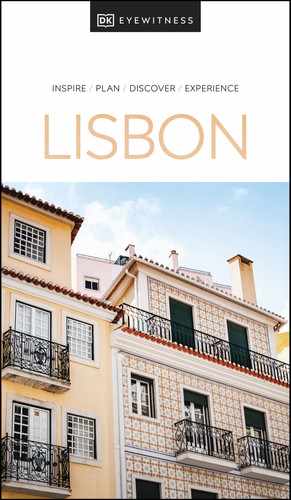experience more
At the top of Avenida da Liberdade, traffic thunders round the “Rotunda” (roundabout), as the praça is also known. At the centre is a lofty 1934 monument to Pombal. The despotic statesman, who virtually ruled Portugal from 1750 to 1777, stands on the top of the column, his hand on a lion (a symbol of power) and his eyes directed down to the Baixa, whose creation he masterminded. Allegorical images depicting Pombal’s political, educational and agricultural reforms decorate the base of the monument. Although greatly feared, this controversial politician propelled the country into the Age of Enlightenment. Broken blocks of stone at the foot of the monument and tidal waves flooding the city are an allegory of the destruction caused by the 1755 earthquake.
Nearby, the well-tended Parque Eduardo VII extends northwards behind the square. The paving stones around the Rotunda are decorated with a mosaic of Lisbon’s coat of arms. Many of the city’s sightseeing operators have their main pick-up located at the bottom of Parque Eduardo VII. There is also a multilingual booth where visitors can buy tickets and plan excursions.

Insider Tip
River Views
Take the passenger ferry from Cais do Sodré across the Tagus to the little port of Cacilhas, where you’ll find many riverfront seafood restaurants and great views of Lisbon back across the water.
Modelled on the Cristo Redentor in Rio de Janeiro (Brazil), this giant-sized statue stands with arms outstretched on the south bank of the Tagus river. The impressive 28-m- (92-ft-) tall figure of Christ, mounted on an 82-m (269-ft) pedestal, was sculpted by Francisco Franco in 1949–59 at the instigation of Prime Minister Salazar.
You can see the monument from various viewpoints in the city, but it is fun to take a ferry from Cais do Sodré to the Margem Sul (the south bank, which until recently was usually simply known as the Outra Banda, or “other bank”), then a bus or taxi to the monument. A lift plus some steps take you up 82 m (269 ft) to the top of the pedestal, affording fine views of the city and river below.

t The mammoth Cristo Rei statue, soaring high into the sky

t Expansive views of the city from the miradouro of Parque Eduardo VII
Central Lisbon’s largest park was named after King Edward VII of the United Kingdom, who came to Lisbon in 1902 to reaffirm the Anglo-Portuguese alliance.
The wide grassy slope, which extends for 25 hectares (62 acres), was laid out as Parque da Liberdade, a continuation of Avenida da Liberdade, in the late 19th century. Neatly clipped box hedging, flanked by mosaic patterned walkways, stretches uphill from the Praça Marquês de Pombal to a belvedere at the top. Here you will find a flower-filled garden dedicated to the memory of renowned Portuguese fado singer Amália Rodrigues, and a pleasant café. The vantage point at the summit of the park offers fine, sweeping views of the city. On clear days you can see as far as the Serra da Arrábida, a nature reserve located 40km (25 miles) from the city centre.
Situated in the northwest corner, the most inspiring feature of this park is the jungle-like Estufa Fria, or greenhouse, where exotic plants, streams and waterfalls provide serene respite from the city streets. At this urban oasis there are in fact three greenhouses: in the Estufa Fria (cold greenhouse), palms push through the slatted bamboo roof and paths wind through a forest of ferns, fuchsias, flowering shrubs and banana trees; the warmer Estufa Quente and Estufa Doce are filled with tropical plants, water-lily ponds and impressive cacti.
Near the estufas, a pond with carp and a galleon-shaped play area are popular with children. On the east side, the Pavilhão Carlos Lopes, named after the 1984 Olympic marathon winner, was extensively refurbished in 2016 and is now used for concerts, exhibitions and conferences.
Experience Beyond the Centre
|
STAY Real Parque Ideally located near Lisbon’s main park, Eduardo VII, Real Parque offers large elegant rooms, some of which have a spacious terrace. ⌂ Avenida Luís Bívar 67, Picoas ∑ realparque.realhotelsgroup.com ¡¡¡ Sheraton This prominent high-rise hotel features stylish rooms with superb views, and a 24-hour fitness centre. It’s also a convenient 15-minute drive from Lisbon airport. ⌂ Rua Latino Coelho 1, Picoas ∑ sheratonlisboa.com ¡¡¡ |

t Ponte 25 de Abril illuminated at night, with the city lights behind
Once called the Ponte Salazar after the dictator who had it built in 1966, Lisbon’s suspension bridge was renamed to commemorate the revolution of 25 April 1974 that restored democracy to Portugal.
Inspired by San Francisco’s Golden Gate Bridge in the US, this steel construction stretches for 2 km (1 mile). The lower tier was modified in 1999 to accommodate the Fertagus, a railway across the Tagus. The bridge’s notorious traffic congestion has been partly resolved by the opening of the 17-km (11-mile) Vasco da Gama bridge, which spans the Tagus river from Montijo to Sacavém, north of the Parque das Nações.

Great View
Ponte 25 de Abril
For a unique experience take the lift up Pillar 7 of this landmark bridge, which offers unbroken views across the river and the city's south bank from 80 m (262 ft) above the waves. Tickets cost around €6.
In the early 1930s, Lisbon’s docks at Alcântara were the city’s main access point. As the importance of the docks declined, the once-industrial riverside has been opened up.
One of the best places to head for is the Doca de Santo Amaro, a largely enclosed dock that sits below the humming traffic of the dramatic Ponte 25 de Abril. The inner edge of the docks is lined with former warehouses, converted in the 1990s and now housing cafés, restaurants and bars with fine views over the water. These tend to be popular, and tables on the outside terraces get snapped up quickly.
Beneath the bridge to the west of the docks is a strange, boomerang-shaped structure, designed to stop falling debris. Continue past this and it’s a good 20-minute walk to Belém.
This museum and cultural centre is dedicated to showing the historical and cultural links between Portugal and its former colonies in the East.
The permanent exhibition is split into two collections. The Portuguese Presence in Asia has a selection of exhibits ranging from furniture and jewellery to porcelain, paintings and textiles. Highlights include 17th- and 18th-century Chinese and Japanese folding screens and some rare examples of Namban art – Portuguese-influenced Japanese art of the 16th and 17th centuries.
The second exhibition is the Kwok On Collection, which features the performing arts of a vast geographic area extending from Turkey to Japan. It includes fine masks from Asia and a section on shadow and puppet theatre from India, China and Indonesia.
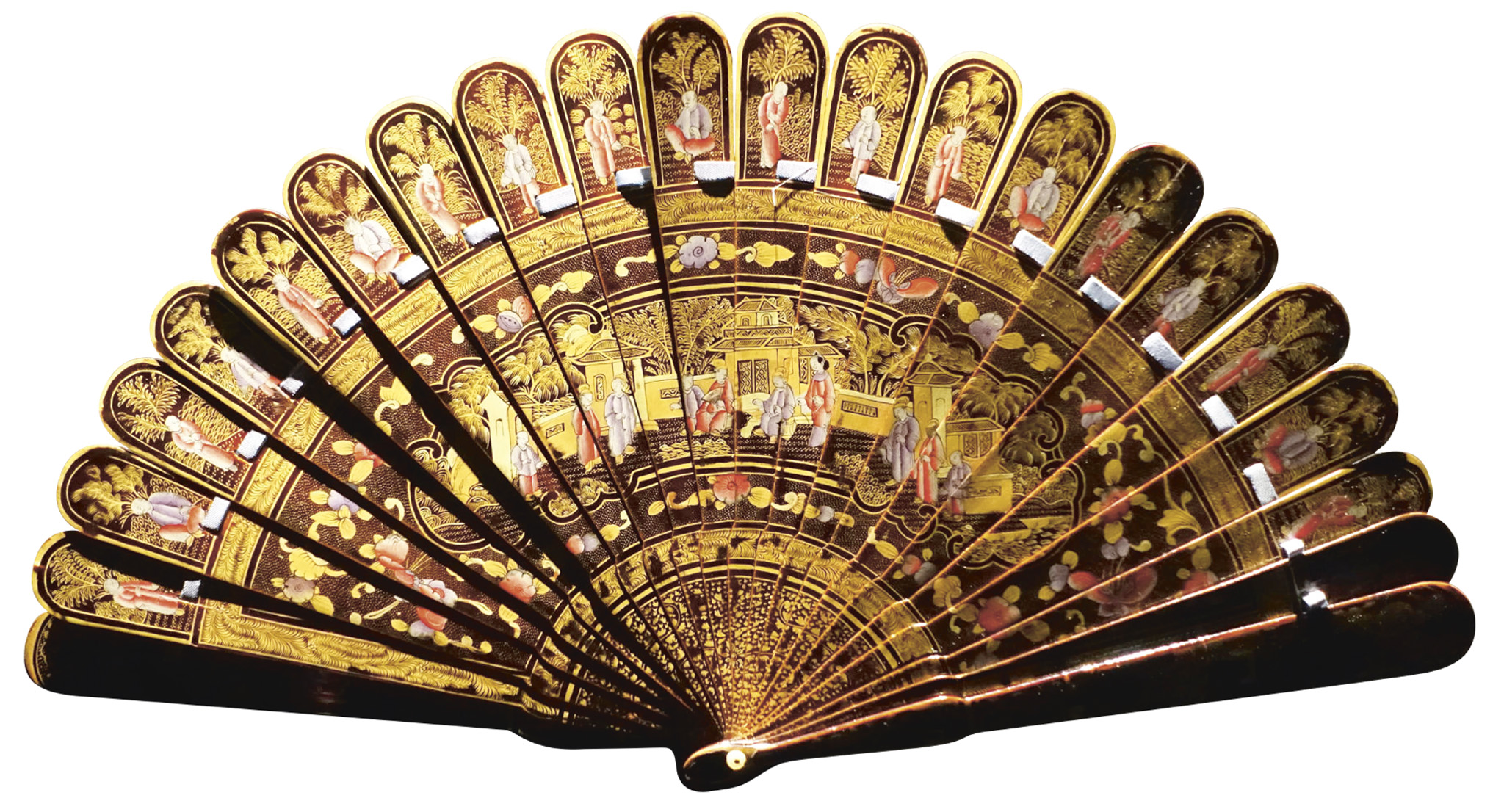
t Brisé fan from China in the Fundação Oriente Museu
Carris is the company that runs Lisbon’s surface public transport and this museum details the history of a system that has had to negotiate a broad river estuary and some serious hills since 1872.
Set in a sprawling former tram depot, the museum is divided into three zones. The first uses various exhibits to trace the development of Lisbon’s public transport. You can then take a fun trip on a tram to the other two zones, which are filled with historic trams and buses, including early horse-drawn varieties.
Down by the river at the bottom of the site, a collection of old shipping containers and double-decker buses make up Village Underground, an innovative work space for Lisbon’s creative set.
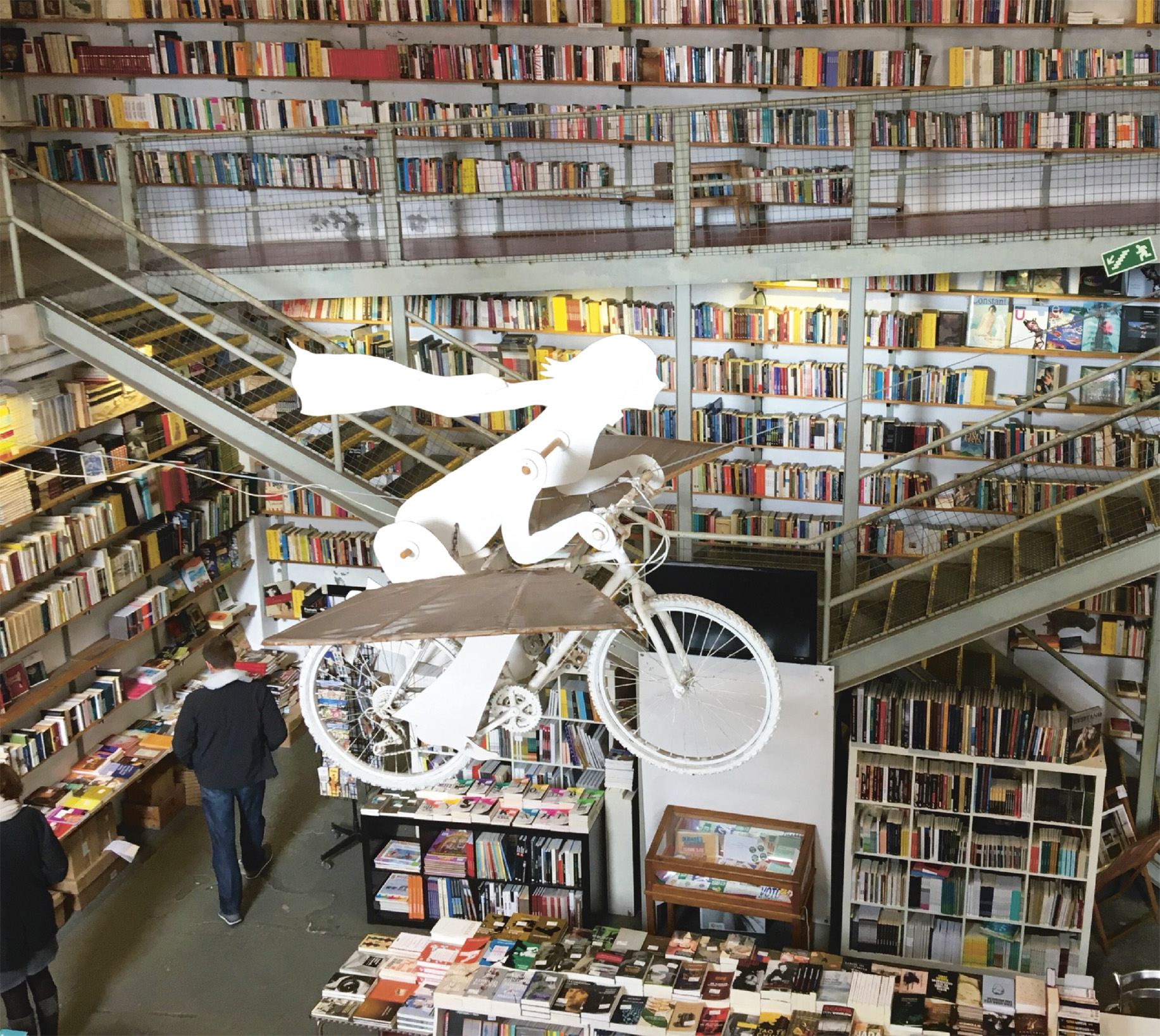
t Shelves stacked to the ceiling at Ler Devagar bookshop in LX Factory
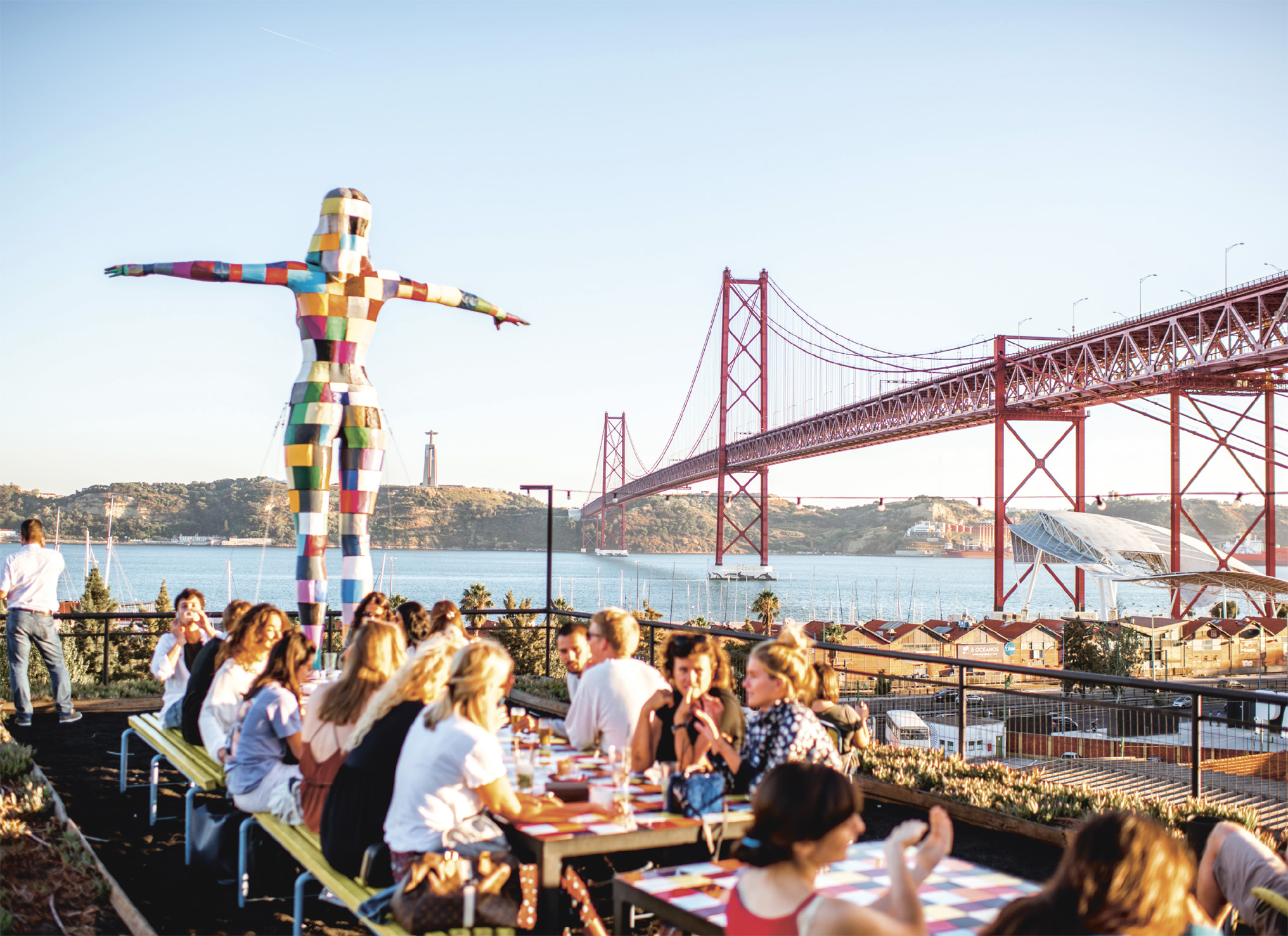
t Ponte 25 de Abril and Cristo Rei, as seen from one of the LX Factory’s buzzing bars
Virtually beneath the Ponte 25 de Abril in a slightly shabby part of town, LX Factory is one of the hippest places in Lisbon. The complex is inside a huge former textiles plant, with the warehouses, factory spaces and courtyards transformed into studios and workshops for the arts, fashion and creative media. Woven among them are innovative cafés, bars, restaurants and shops. Visit on Sunday morning when a lively flea market takes place.
Experience Beyond the Centre
|
SHOP Colombo Shopping Centre This is Lisbon’s largest shopping centre. The sprawling complex houses over 340 stores, including many well-known brands, more than 60 restaurants and an IMAX cinema. ⌂ Avenida Lusiada ∑ colombo.pt El Corte Inglés A large department store with a fantastic food hall, supermarket and nine floors selling everything from home furnishings to designer clothes. Upmarket international brands – including Ralph Lauren and Versace – can be found here. ⌂ Avenida António de Aguiar ∑ elcorteingles.pt |
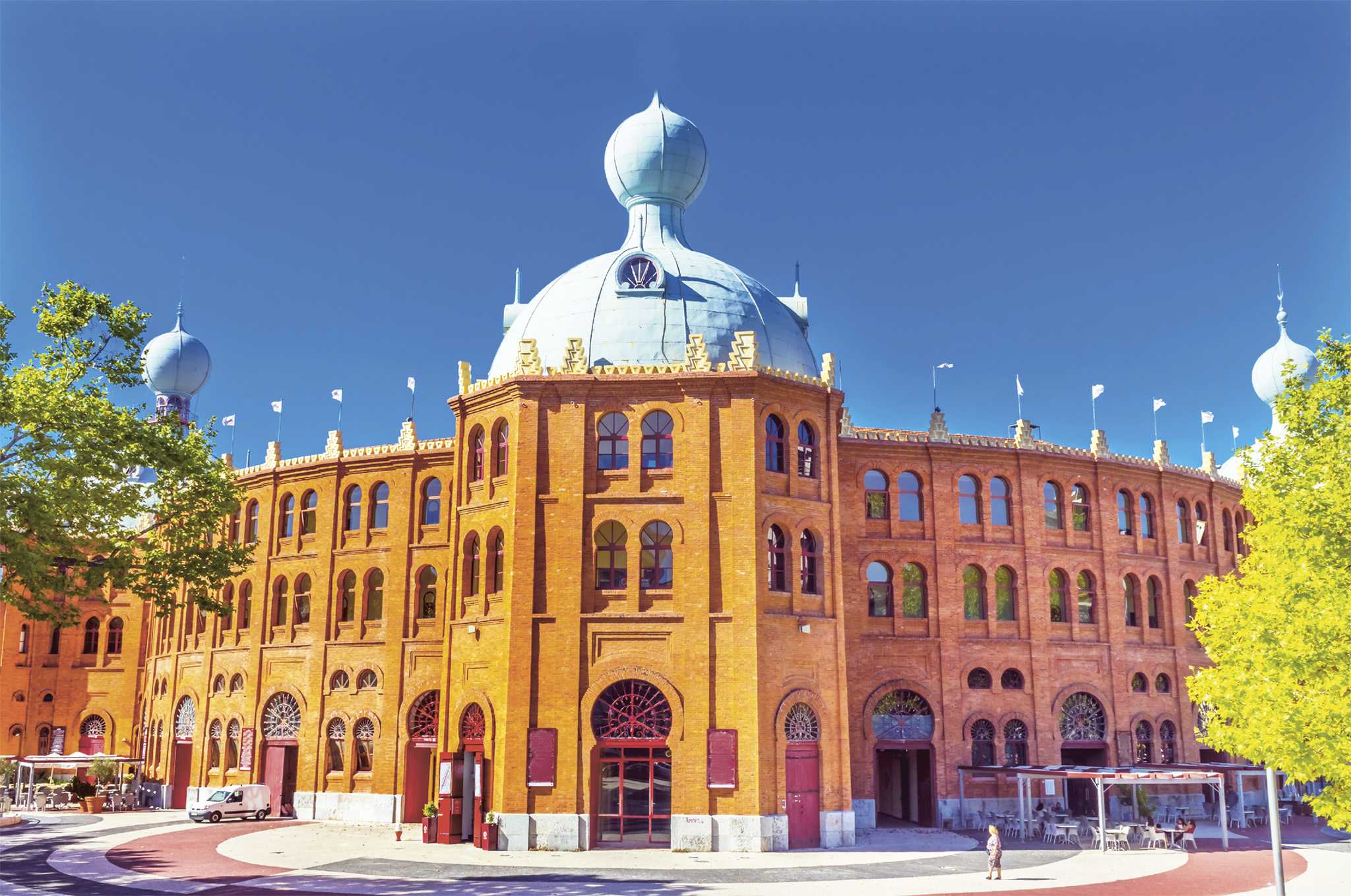
t Neo-Moorish façade of the bullring in Campo Pequeno
This square is dominated by the red-brick Neo-Moorish bullring built in the late 19th century. The building has undergone development, and a car park and leisure centre have been added. Much of the bullring’s distinctive architecture, such as keyhole-shaped windows and double cupolas, have been retained.
Dedicated to the history of Lisbon’s water supply, this informative museum was imaginatively created around the city’s first steam pumping station. It commemorates Manuel da Maia, the 18th-century engineer behind the Águas Livres aqueduct.
Pride of place goes to four steam engines, one of which still functions (by electricity). The development of technology relating to the city’s water supply is documented with photographs. Particularly interesting is the exhibit on the Alfama’s 17th-century Chafariz d’El Rei, one of Lisbon’s first fountains. Locals used to queue at one of six founts, depending on their social status.
Originally the site of Expo 98, Parque das Nações is now a Lisbon hub. With its contemporary architecture and family-oriented attractions, the park has renewed the eastern waterfront, which was once an industrial wasteland. The soaring geometry of the platform canopies over Santiago Calatrava’s Oriente Station set the architectural tone. The Portugal Pavilion has a large reinforced concrete roof suspended like a sailcloth above its forecourt.
Pavilhão do Conhecimento – Ciencia Viva is a fascinating modern museum of science and technology that houses several interactive exhibitions.
Spectacular views can be had from the cable car that links the Torre Vasco da Gama with the marina. The promenade along the river also offers delightful views, including of the Vasco da Gama bridge. Also in the area is the Altice Arena.
Did You Know?
The Vasco da Gama bridge (near the Parque das Nações) is Europe's longest, stretching 17 km (11 miles).
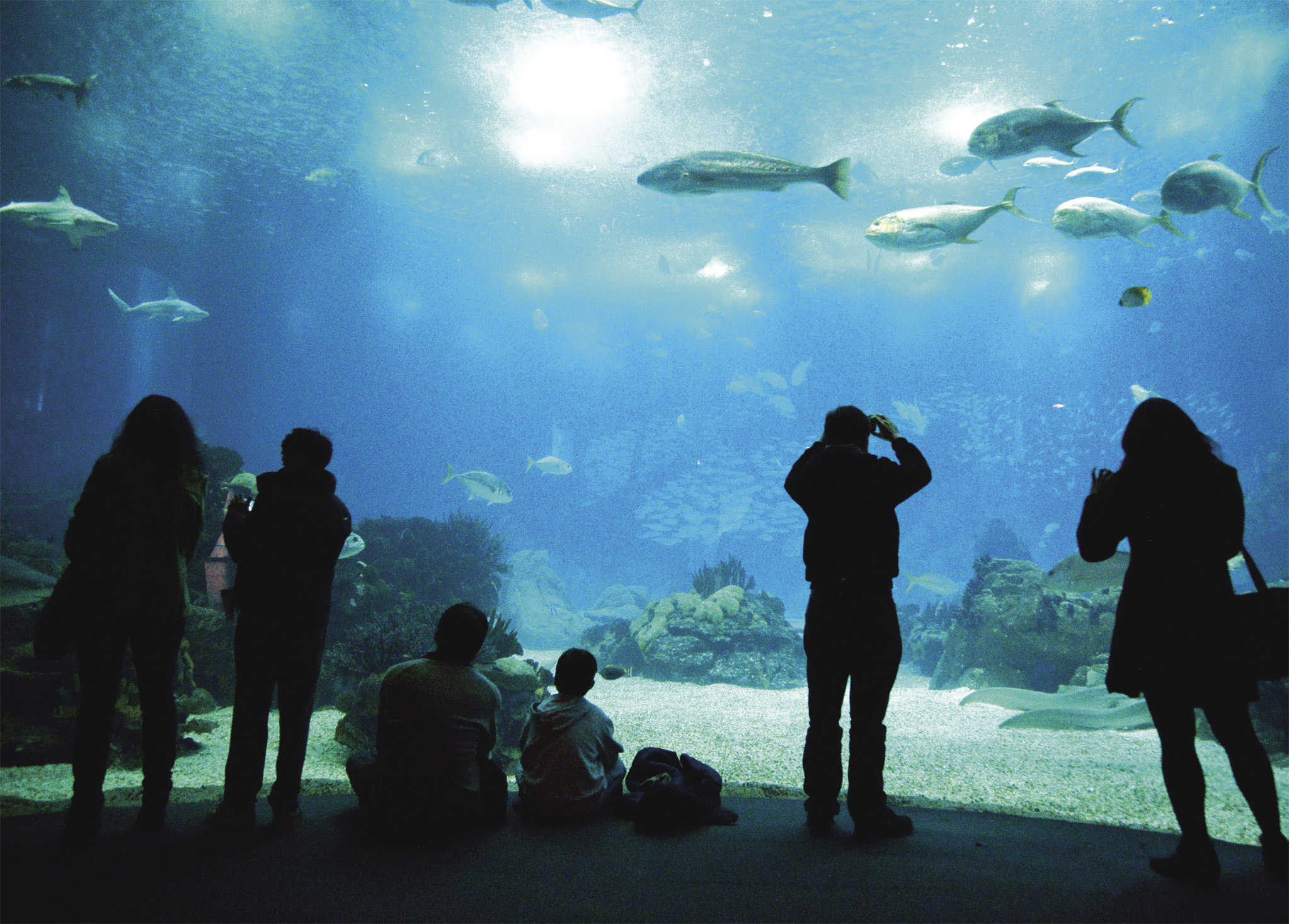
t Visitors watching the fish in the central tank at Oceanário de Lisboa
The main attraction at Parque das Nações, the oceanarium was designed by American architect Peter Chermayeff, and is perched on the end of a pier. It holds an impressive array of species – birds and some mammals as well as fish and other underwater dwellers.
Landscapes represent the habitats of the Atlantic, Pacific, Indian and Antarctic oceans, with suitable fauna and flora. The aquarium’s vast central tank has a dazzling variety of fish, large and small. Sharks co-exist peaceably with bream in the softly lit waters.
The Museum of Lisbon is housed in a summer place, which is framed by the remains of an old manor farm. The palace was built between 1734 and 1746, at the request of Diogo de Sousa Mexia; the architect is unknown. When the mansion was built it occupied a quiet site outside the city. Today it contends with the traffic of Campo Grande. The house itself, however, retains its period charm.
The displays follow the development of the city, from prehistoric times through the Romans, Visigoths and Moors, traced by means of drawings tiles, paintings, models and historical documents. Notable exhibits are those depicting the city before the earthquake of 1755, including a highly detailed model made in the 1950s and an impressive 17th- century oil painting by Dirk Stoop (1610–86) of Terreiro do Paço, as Praça do Comércio was known then. One room is devoted to the Águas Livres aqueduct, with architectural plans as well as prints and watercolours of the completed aqueduct.
The earthquake theme is resumed with pictures of the city amid the devastation and various plans for its reconstruction. The museum brings you into the 20th century with a large colour poster celebrating the Revolution of 1910 and the proclamation of the new republic.
Experience Beyond the Centre
|
EAT Eleven Michelin-star dining and stunning city views are on offer at this airy, modern restaurant. Opt for an à la carte or a tasting menu. The “Lisbon Menu”, which is a tribute to the city’s multicultural culinary influences, is a pop-ular choice. ⌂ Rua Marquês da Fronteira, Jardim Amália Rodrigues ¢ Sun ∑ restauranteleven.com ¡¡¡ Restaurante Farol This centuries-old establishment is the best-known seafood restaurant in Cacilhas. Foodies seek out this spot for its tasty lobsters, great views across the Tagus river and fine-tasting beer. ⌂ Largo Alfredo Dinis 1, Cacilhas ∑ restaurantefarol.com ¡¡¡ Pastelaria Versailles A wonderful array of cakes and pastries are on offer at this traditional café, which dates from the early 1920s. Good-value lunches are also served, while the decadent, cream-topped hot chocolate makes a tasty treat on chilly afternoons. ⌂ Avenida da República 15a, Saldanha § 213 546 340 ¡¡¡ |
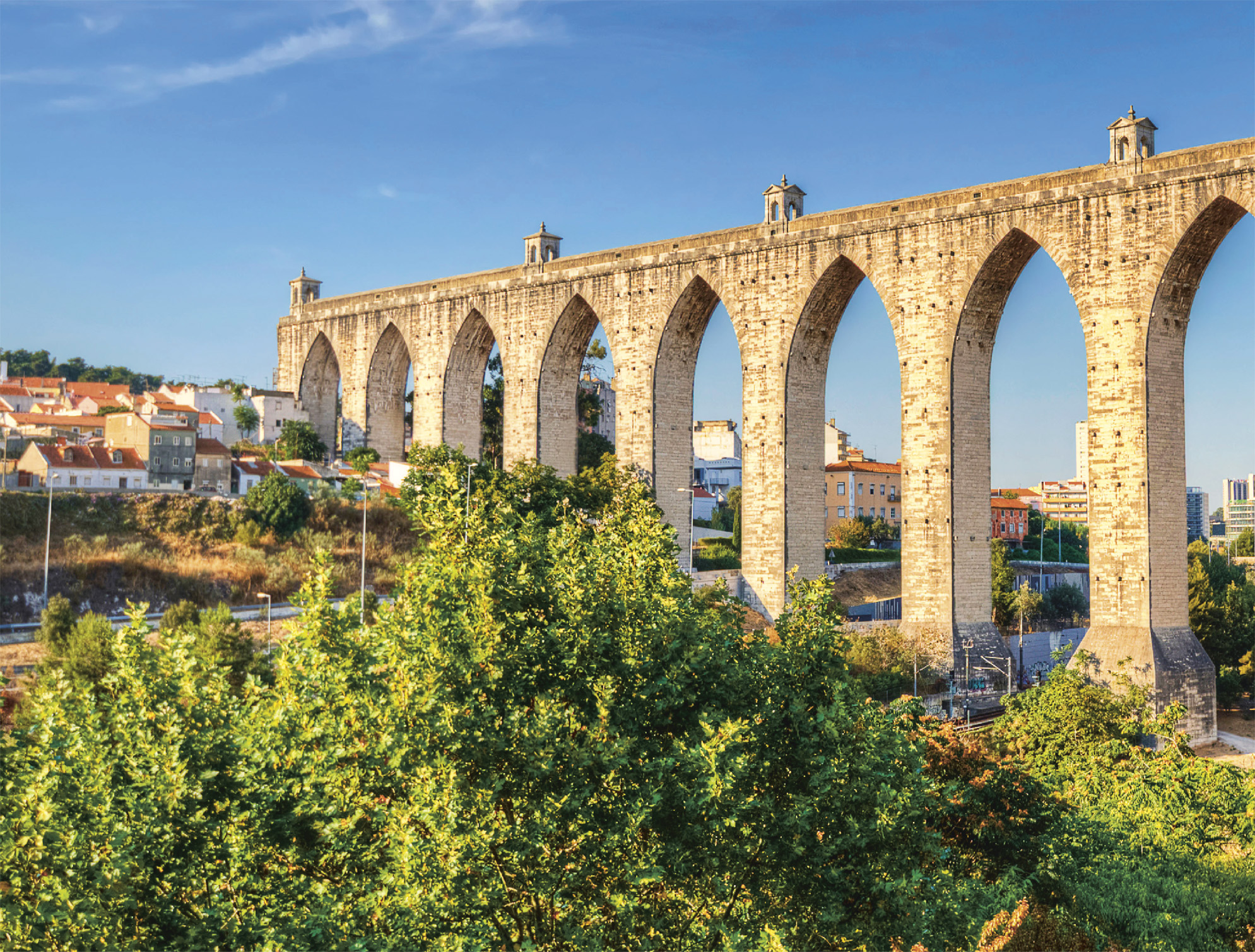
t Imposing arches of the Aqueduto das Águas Livres
Considered the most beautiful sight in Lisbon at the turn of the 20th century, the impressive structure of Aqueduto das Águas Livres looms over the Alcântara valley northwest of the city. The construction of an aqueduct gave João V the opportunity to indulge his passion for grandiose building schemes, as the only area of Lisbon with fresh drinking water was the Alfama. A tax on meat, wine, olive oil and other comestibles funded the project, and although not complete until the 19th century, it was already supplying the city with water by 1748. The main pipeline measures 19 km (12 miles), but the total length, including all the secondary channels, is 58 km (36 miles). The most visible part of this imposing structure are the 35 arches crossing the Alcântara valley, the tallest of which rise to 65 m (213 ft) above ground.
It is possible to take guided tours over the Alcântara arches. There are also tours of the Mãe d’Água reservoir and trips to the Mãe d’Água springs. Contact the Museu da Água for details of the trips.
At the end of the aqueduct, the Mãe d’Água das Amoreiras is a castle-like building that served as a reservoir for the water supplied from the aqueduct. Today the space is used for art exhibitions, fashion shows and other events.
Did You Know?
Aqueduto das Águas Livres only stopped supplying water for human consumption in the 1960s.

t Leading to the chapel of the Palácio Fronteira
This country manor house was built as a hunting pavilion for João de Mascarenhas, the first Marquês de Fronteira, in 1640. Although skyscrapers are visible in the distance, it still occupies a quiet spot, by the Parque Florestal de Monsanto. Both house and garden have azulejo decoration whose subjects include battle scenes and trumpet-blowing monkeys.
Although the palace is still occupied by the 12th marquis, some of the living rooms and the library, as well as the formal gardens, are included in the tour. The Battles Room has lively tiled panels depicting scenes of the War of Restoration (1640–68), with a detail of João de Fronteira fighting a Spanish general. It was his loyalty to Pedro II during this war that earned him the title of Marquês. Interesting comparisons can be made between these naive 17th-century Portuguese tiles and the Delft ones from the same period in the dining room, depicting naturalistic scenes. The dining room is also decorated with frescoed panels and portraits of Portuguese nobility.
The late-16th-century chapel is the oldest part of the house. The façade is adorned with stones, shells, broken glass and bits of china. These fragments of crockery are believed to have been used at the feast inaugurating the palace and then smashed to ensure no one else could sup off the same set. Visits to the garden start at the chapel terrace, where tiled niches are decorated with figures personifying the arts and mythological creatures.
In the formal Italian garden the immaculate box hedges are cut into shapes to represent the seasons of the year. To one end, tiled scenes of dashing knights on horseback, representing ancestors of the Fronteira family, are reflected in the waters of a large tank. On either side of the water, a grand staircase leads to a terrace above. Here, decorative niches contain the busts of Portuguese kings and colourful majolica reliefs adorn the arcades. More blue-and-white tiled scenes, realistic and allegorical, decorate the wall at the far end of the garden.
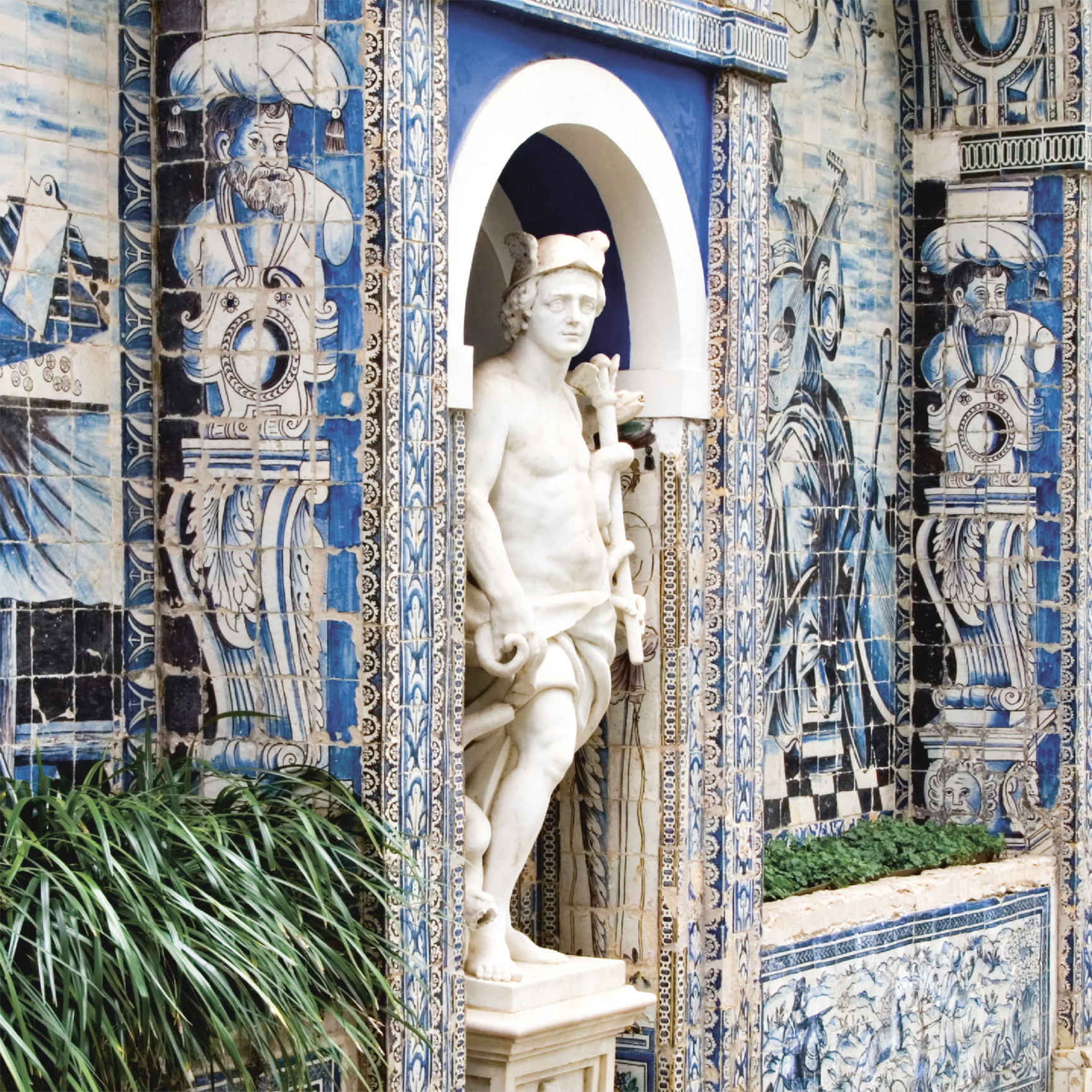
t Tiled terrace, decorated with figures

Insider Tip
Catch a Match
Two of Europe’s leading football clubs play in Lisbon: Sporting Lisbon launched the career of Cristiano Ronaldo, while Benfica have two European Cups to their name. Tickets can be bought at the stadiums or online.
Monteiro-Mor park was sold to the state in 1975 and the 18th-century palace buildings were converted to museums. The gardens are attractive; much of the land is wooded, though the area around the museums has gardens with duck ponds and tropical trees.
The slightly old-fashioned Museu Nacional do Traje (Costume Museum) has a vast collection of textiles, accessories and costumes worn by people of note.
The Museu Nacional do Teatro has two buildings: one devoted to temporary exhibitions, the other containing a small permanent collection. Photographs, posters and cartoons feature famous 20th-century Portuguese actors, and one section is devoted to Amália Rodrigues, the famous fado singer. The permanant collection space is currently closed for renovation.
"
Museu Nacional do Traje
# 2–6pm Tue, 10am–6pm Wed–Sun ∑ museudotraje.gov.pt
"
Museu Nacional do Teatro
# 10am–6pm Tue–Sun ¢ 1 Jan, Easter, 1 May, 13 Jun,25 Dec ∑ museudoteatroedanca.gov.pt
